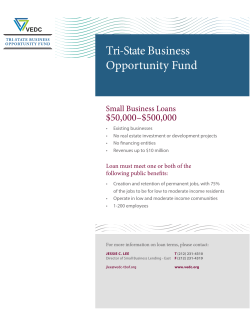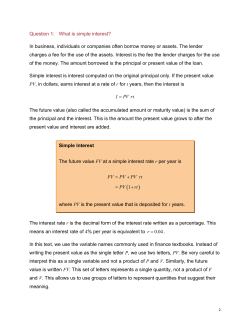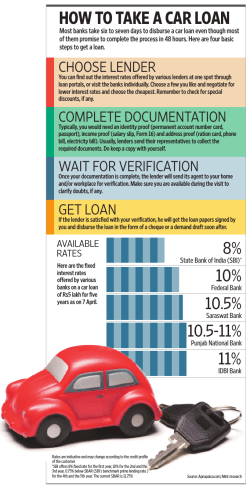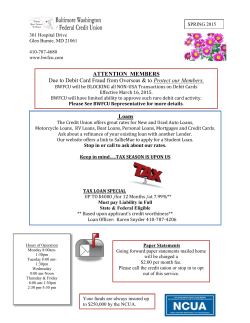
Lecture 09: Further Readings 04: Interest
Interest For other uses, see Interest (disambiguation). deposits of dowry, since the silver being used in exchange for livestock or grain could not multiply of its own. Interest is a fee paid by a borrower of assets to the owner as a form of compensation for the use of the assets. It is most commonly the price paid for the use of borrowed money,[1] or money earned by deposited funds.[2] The First Council of Nicaea, in 325, forbade clergy from engaging in usury[5] which was defined as lending on interest above 1 percent per month (12.7% APR). Later ecumenical councils applied this regulation to the laity.[5][6] Catholic Church opposition to interest hardened in the era of scholastics, when even defending it was considered a heresy. St. Thomas Aquinas, the leading theologian of the Catholic Church, argued that the charging of interest is wrong because it amounts to "double charging", charging for both the thing and the use of the thing. When money is borrowed, interest is typically paid to the lender as a percentage of the principal, the amount owed to the lender. The percentage of the principal that is paid as a fee over a certain period of time (typically one month or year) is called the interest rate. A bank deposit will earn interest because the bank is paying for the use of the deposited funds. Assets that are sometimes lent with interest include money, shares, consumer goods through hire purchase, major assets such as aircraft, and even entire factories in finance lease arrangements. The interest is calculated upon the value of the assets in the same manner as upon money. In the medieval economy, loans were entirely a consequence of necessity (bad harvests, fire in a workplace) and, under those conditions, it was considered morally reproachable to charge interest. It was also considered morally dubious, since no goods were produced through the lending of money, and thus it should not be compensated, unlike other activities with direct physical output such as blacksmithing or farming.[7] For the same reason, interest has often been looked down upon in Islamic civilization, with most scholars agreeing that the Qur'an explicitly forbids charging interest. Interest is compensation to the lender, for a) risk of principal loss, called credit risk; and b) forgoing other investments that could have been made with the loaned asset. These forgone investments are known as the opportunity cost. Instead of the lender using the assets directly, they are advanced to the borrower. The borrower then enjoys the benefit of using the assets ahead of the effort required to pay for them, while the lender enjoys the benefit of the fee paid by the borrower for the privilege. In economics, interest is considered the price of credit. Medieval jurists developed several financial instruments to encourage responsible lending and circumvent prohibitions on usury, such as the Contractum trinius. In the Renaissance era, greater mobility of people facilitated an increase in commerce and the appearance of appropriate conditions for entrepreneurs to start new, lucrative businesses. Given that borrowed money was no longer strictly for consumption but for production as well, interest was no longer viewed in the same manner. The School of Salamanca elaborated on various reasons that justified the charging of interest: the person who received a loan benefited, and one could consider interest as a premium paid for the risk taken by the loaning party. Interest is often compounded, which means that interest is earned on prior interest in addition to the principal. The total amount of debt grows exponentially, most notably when compounded at infinitesimally small intervals, and its mathematical study led to the discovery of the number e.[3] However, in practice, interest is most often calculated on a daily, monthly, or yearly basis, and its impact is influenced greatly by its compounding rate. 1 There was also the question of opportunity cost, in that the loaning party lost other possibilities of using the loaned money. Finally and perhaps most originally was the consideration of money itself as merchandise, and the use of one’s money as something for which one should receive a benefit in the form of interest. Martín de Azpilcueta also considered the effect of time. Other things being equal, one would prefer to receive a given good now rather than in the future. This preference indicates greater value. Interest, under this theory, is the payment for the time the loaning individual is deprived of the money. History of interest According to historian Paul Johnson, the lending of “food money” was commonplace in Middle East civilizations as far back as 5000 BC. They regarded interest as legitimate since acquired seeds and animals could “reproduce themselves"; whilst the ancient Jewish religious prohibitions against usury ( נשךNeSheKh) were a “different view”.[4] On this basis, the Laws of Eshnunna (early 2nd millennium BC) instituted a legal interest rate, specifically on 1 2 2 TYPES OF INTEREST the service of lending. 2 Types of interest Simple interest is calculated only on the principal amount, or on that portion of the principal amount that remains. The amount of simple interest is calculated according to the following formula: Isimple = r · B0 · mt where r is the period interest rate (I/m), B0 the initial balance and mt the number of time periods elapsed. To calculate the period interest rate r, one divides the interest rate I by the number of periods mt. For example, imagine that a credit card holder has an outstanding balance of $2500 and that the simple interest rate is 12.99% per annum. The interest added at the end of 3 months would be, ( Of Usury, from Brant’s Stultifera Navis (the Ship of Fools); woodcut attributed to Albrecht Dürer Isimple = ) 0.1299 · $2500 · 3 = $81.19 12 and they would have to pay $2581.19 to pay off the balEconomically, the interest rate is the cost of capital ance at this point. and is subject to the laws of supply and demand of the If instead they make interest-only payments for each of money supply. The first attempt to control interest rates those 3 months at the period rate r, the amount of interest through manipulation of the money supply was made by paid would be, the French Central Bank in 1847. The first formal studies of interest rates and their impact on society were conducted by Adam Smith, Jeremy Bentham and Mirabeau during the birth of classic economic thought. In the late 19th century leading Swedish economist Knut Wicksell in his 1898 Interest and Prices elaborated a comprehensive theory of economic crises based upon a distinction between natural and nominal interest rates. In the early 20th century, Irving Fisher made a major breakthrough in the economic analysis of interest rates by distinguishing nominal interest from real interest. Several perspectives on the nature and impact of interest rates have arisen since then. ( I= ) 0.1299 · $2500 ·3 = ($27.0625/month)·3 = $81.19 12 Their balance at the end of 3 months would still be $2500. In this case, the time value of money is not factored in. The steady payments have an additional cost that needs to be considered when comparing loans. For example, given a $100 principal: • Credit card debt where $1/day is charged: 1/100 = 1%/day = 7%/week = 365%/year. The latter half of the 20th century saw the rise of interest• Corporate bond where the first $3 are due after six free Islamic banking and finance, a movement that atmonths, and the second $3 are due at the year’s end: tempts to apply religious law developed in the medieval (3 + 3)/100 = 6%/year. period to the modern economy. Some entire countries, • Certificate of deposit (GIC) where $6 is paid at the including Iran, Sudan, and Pakistan, have taken steps year’s end: 6/100 = 6%/year. to eradicate interest from their financial systems altogether. Rather than charging interest, the interest-free lender shares the risk by investing as a partner in profit There are two complications involved when comparing loss sharing scheme, because predetermined loan repay- different simple interest bearing offers. ment as interest is prohibited, as well as making money 1. When rates are the same but the periods are differout of money is unacceptable. All financial transactions ent a direct comparison is inaccurate because of the must be asset-backed and it does not charge any “fee” for 2.2 Cumulative interest or return 3 time value of money. Paying $3 every six months loan and σ is the representative value for the risk engaged costs more than $6 paid at year end so, the 6% bond in the operation. cannot be 'equated' to the 6% GIC. 2. When interest is due, but not paid, does it remain 'interest payable', like the bond’s $3 payment after six months or, will it be added to the balance due? In the latter case it is no longer simple interest, but compound interest. 2.2 Cumulative interest or return The calculation for cumulative interest is (FV/PV) − 1. It ignores the 'per year' convention and assumes compounding at every payment date. It is usually used to compare two long term opportunities. A bank account that offers only simple interest, that money can freely be withdrawn from is unlikely, since withdrawing money and immediately depositing it again 2.3 Other conventions and uses would be advantageous. Exceptions: 2.1 Composition of interest rates In economics, interest is considered the price of credit, therefore, it is also subject to distortions due to inflation. The nominal interest rate, which refers to the price before adjustment to inflation, is the one visible to the consumer (i.e., the interest tagged in a loan contract, credit card statement, etc.). Nominal interest is composed of the real interest rate plus inflation, among other factors. A simple formula for the nominal interest is: i=r+π • US and Canadian T-Bills (short term Government debt) have a different calculation for interest. Their interest is calculated as (100 − P)/P where P is the price paid. Instead of normalizing it to a year, the interest is prorated by the number of days t: (365/t)·100. (See also: Day count convention). The total calculation is ((100 − P)/P)·((365/t)·100). This is equivalent to calculating the price by a process called discounting at a simple interest rate. • Corporate Bonds are most frequently payable twice yearly. The amount of interest paid is the simple interest disclosed divided by two (multiplied by the face value of debt). Where i is the nominal interest, r is the real interest and Flat Rate Loans and the Rule of .78s: Some consumer π is inflation. loans have been structured as flat rate loans, with the loan This formula attempts to measure the value of the in- outstanding determined by allocating the total interest terest in units of stable purchasing power. However, if across the term of the loan by using the "Rule of 78s" or this statement were true, it would imply at least two mis- “Sum of digits” method. Seventy-eight is the sum of the conceptions. First, that all interest rates within an area numbers 1 through 12, inclusive. The practice enabled that shares the same inflation (that is, the same country) quick calculations of interest in the pre-computer days. should be the same. Second, that the lenders know the In a loan with interest calculated per the Rule of 78s, the inflation for the period of time that they are going to lend total interest over the life of the loan is calculated as either the money. simple or compound interest and amounts to the same as One reason behind the difference between the interest either of the above methods. Payments remain constant that yields a treasury bond and the interest that yields a over the life of the loan; however, payments are allocated mortgage loan is the risk that the lender takes from lend- to interest in progressively smaller amounts. In a one-year ing money to an economic agent. In this particular case, loan, in the first month, 12/78 of all interest owed over a government is more likely to pay than a private citizen. the life of the loan is due; in the second month, 11/78; Therefore, the interest rate charged to a private citizen is progressing to the twelfth month where only 1/78 of all interest is due. The practical effect of the Rule of 78s is larger than the rate charged to the government. to make early pay-offs of term loans more expensive. For To take into account the information asymmetry aforea one-year loan, approximately 3/4 of all interest due is mentioned, both the value of inflation and the real price collected by the sixth month, and pay-off of the princiof money are changed to their expected values resulting pal then will cause the effective interest rate to be much in the following equation: higher than the APY used to calculate the payments. [8] In 1992, the United States outlawed the use of “Rule of 78s” interest in connection with mortgage refinancing and it = r(t+1) + π(t+1) + σ other consumer loans over five years in term.[9] Certain Here, it is the nominal interest at the time of the loan, other jurisdictions have outlawed application of the Rule r₍t₊₁₎ is the real interest expected over the period of the of 78s in certain types of loans, particularly consumer loan, π₍ ₊₁₎ is the inflation expected over the period of the loans.[8] 4 3 Rule of 72: The "Rule of 72" is a “quick and dirty” method for finding out how fast money doubles for a given interest rate. For example, if you have an interest rate of 6%, it will take 72/6 or 12 years for your money to double, compounding at 6%. This is an approximation that starts to break down above 10%. 3 Market interest rates There are markets for investments (which include the money market, bond market, as well as retail financial institutions like banks) set interest rates. Each specific debt takes into account the following factors in determining its interest rate: 3.1 Opportunity cost Opportunity cost encompasses any other use to which the money could be put, including lending to others, investing elsewhere, holding cash (for safety, for example), and simply spending the funds. 3.2 Inflation Since the lender is deferring consumption, they will wish, as a bare minimum, to recover enough to pay the increased cost of goods due to inflation. Because future inflation is unknown, there are three ways this might be achieved: MARKET INTEREST RATES risk premium attempts to measure the integrity of the borrower, the risk of his enterprise succeeding and the security of any collateral pledged. For example, loans to developing countries have higher risk premiums than those to the US government due to the difference in creditworthiness. An operating line of credit to a business will have a higher rate than a mortgage loan. The creditworthiness of businesses is measured by bond rating services and individual’s credit scores by credit bureaus. The risks of an individual debt may have a large standard deviation of possibilities. The lender may want to cover his maximum risk, but lenders with portfolios of debt can lower the risk premium to cover just the most probable outcome. 3.4 Default interest Default interest is the rate of interest that a borrower must pay thenceforth in the event of material breach of the loan covenants. The default interest is usually much higher than the original interest rate since it is reflecting the aggravation in the financial risk of the borrower. Default interest compensates the lender for the added risk. From the borrower’s perspective, this means failure to make their regular payment for one or two payment periods or failure to pay taxes or insurance premiums for the loan collateral will lead to substantially higher interest for the entire remaining term of the loan. Banks tend to add default interest to the loan agreements • Charge X% interest 'plus inflation' Many govern- in order to separate between different scenarios. ments issue 'real-return' or 'inflation indexed' bonds. The principal amount or the interest payments are In some jurisdictions, default interest clauses are unencontinually increased by the rate of inflation. See forceable as against public policy. the discussion at real interest rate. • Decide on the 'expected' inflation rate. This still leaves the lender exposed to the risk of 'unexpected' 3.5 Deferred consumption inflation. Charging interest equal only to inflation will leave the • Allow the interest rate to be periodically changed. lender with the same purchasing power, but they would While a 'fixed interest rate' remains the same prefer their own consumption sooner rather than later. throughout the life of the debt, 'variable' or 'floating' There will be an interest premium of the delay. They rates can be reset. There are derivative products that may not want to consume, but instead would invest in anallow for hedging and swaps between the two. other product. The possible return they could realize in competing investments will determine what interest they However interest rates are set by the market, and it hap- charge. pens frequently that they are insufficient to compensate for inflation: for example at times of high inflation during e.g. the oil crisis; and currently (2011) when real yields on many inflation-linked government stocks are negative. 3.6 Length of time Shorter terms often have less risk of default and exposure to inflation because the near future is easier to predict. In these circumstances, short-term interest rates are lower There is always the risk the borrower will become than longer-term interest rates (an upward sloping yield bankrupt, abscond or otherwise default on the loan. The curve). 3.3 Default 3.10 Money and inflation 5 3.7 Government intervention 3.10 Money and inflation Interest rates are generally determined by the market, but government intervention - usually by a central bank - may strongly influence short-term interest rates, and is one of the main tools of monetary policy. The central bank offers to borrow (or lend) large quantities of money at a rate which they determine (sometimes this is money that they have created ex nihilo, i.e. printed) which has a major influence on supply and demand and hence on market interest rates. Loans and bonds have some of the characteristics of money and are included in the broad money supply. National governments (provided, of course, that the country has retained its own currency) can influence interest rates and thus the supply and demand for such loans, thus altering the total of loans and bonds issued. Generally speaking, a higher real interest rate reduces the broad money supply. Through the quantity theory of money, increases in the money supply lead to inflation. This means that interest Open market operations in the United rates can affect inflation in the future. 3.8 States 4 Interest in mathematics Federal Funds Rate (effective) 1954-06 to 2014-05 20 18 16 Percent 14 12 10 8 6 4 2 0 1952 1958 1964 1970 1976 1982 1988 1994 2000 2006 2012 2018 Date It is thought that Jacob Bernoulli discovered the mathematical constant e by studying a question about compound interest.[10] He realized that if an account that starts with $1.00 and pays say 100% interest per year, at the end of the year, the value is $2.00; but if the interest is computed and added twice in the year, the $1 is multiplied by 1.5 twice, yielding $1.00×1.52 = $2.25. Compounding quarterly yields $1.00×1.254 = $2.4414…, and so on. The effective federal funds rate charted over more than fifty years. Bernoulli noticed that if the frequency of compounding is increased without limit, this sequence can be modeled as follows: The Federal Reserve (Fed) implements monetary policy largely by targeting the federal funds rate. This is the rate that banks charge each other for overnight loans of federal funds. Federal funds are the reserves held by banks at the Fed. ( )n 1 lim 1 + = e, n→∞ n Open market operations are one tool within monetary policy implemented by the Federal Reserve to steer shortterm interest rates. Using the power to buy and sell treasury securities, the Open Market Desk at the Federal Reserve Bank of New York can supply the market with dollars by purchasing U.S. Treasury notes, hence increasing the nation’s money supply. By increasing the money supply or Aggregate Supply of Funding (ASF), interest rates will fall due to the excess of dollars banks will end up with in their reserves. Excess reserves may be lent in the Fed funds market to other banks, thus driving down rates. 3.9 Interest rates and credit risk It is increasingly recognized that during the business cycle, interest rates and credit risk are tightly interrelated. The Jarrow-Turnbull model was the first model of credit risk that explicitly had random interest rates at its core. Lando (2004), Darrell Duffie and Singleton (2003), and van Deventer and Imai (2003) discuss interest rates when the issuer of the interest-bearing instrument can default. where n is the number of times the interest is to be compounded in a year. 5 Formulas The balance of a loan with regular monthly payments is augmented by the monthly interest charge and decreased by the payment so ( ) Bk+1 = 1 + r Bk − p, where i = loan rate/100 = annual rate in decimal form (e.g. 10% = 0.10 The loan rate is the rate used to compute payments and balances.) r = period rate = i/12 for monthly payments (customary usage for convenience) B0 = initial balance (loan principal) 6 5 Bk = balance after k payments FORMULAS and k = balance index p = period (monthly) payment pk = p rk . r By repeated substitution one obtains expressions for Bk, The last equation allows us to define a constant that is the which are linearly proportional to B0 and p and use of the same for both problems, formula for the partial sum of a geometric series results in pk p B∗ = = r rk (1 + r)k − 1 k Bk = (1 + r) B0 − p and Bk can be written as r A solution of this expression for p in terms of B0 and Bn reduces to [ (1 + r)n B0 − Bn p=r (1 + r)n − 1 ] Bk = (1 + rk )B0 − rk B ∗ . Solving for rk we find a formula for rk involving known quantities and Bk, the balance after k periods, To find the payment if the loan is to be finished in n payB0 − Bk rk = ∗ ments one sets Bn = 0. B − B0 The PMT function found in spreadsheet programs can be Since B0 could be any balance in the loan, the formula used to calculate the monthly payment of a loan: works for any two balances separate by k periods and can be used to compute a value for the annual interest rate. p = PMT(rate, num, PV, FV, ) = PMT(r, n, −B0 , Bn , ) B* is a scale invariant since it does not change with changes in the length of the period. An interest-only payment on the current balance would Rearranging the equation for B* one gets a transformation be coefficient (scale factor), λk = ppk = rrk = (1+r)r −1 = ] [ + · · · (see binomial theorem) k 1 + (k−1)r 2 k pI = rB. The total interest, IT, paid on the loan is and we see that r and p transform in the same manner, IT = np − B0 . The formulas for a regular savings program are similar but the payments are added to the balances instead of being subtracted and the formula for the payment is the negative of the one above. These formulas are only approximate since actual loan balances are affected by rounding. To avoid an underpayment at the end of the loan, the payment must be rounded up to the next cent. rk = λk r pk = λk p The change in the balance transforms likewise, ∆Bk = B ′ − B = (λk rB − λk p) = λk ∆B Consider a similar loan but with a new period equal to k periods of the problem above. If rk and pk are the new which gives an insight into the meaning of some of the coefficients found in the formulas above. The annual rate, rate and payment, we now have r12 , assumes only one payment per year and is not an “effective” rate for monthly payments. With monthly payments the monthly interest is paid out of each payment ′ Bk = B0 = (1 + rk )B0 − pk . and so should not be compounded and an annual rate of Comparing this with the expression for B above we note 12·r would make more sense. If one just made interestonly payments the amount paid for the year would be that 12·r·B0 . rk = (1 + r)k − 1 Substituting pk = rk B* into the equation for the Bk we get, 7 • Interest expense Bk = B0 − rk (B ∗ − B0 ) • Interest rate Since Bn = 0 we can solve for B*, • Leasing • Monetary policy B ∗ = B0 ( ) 1 +1 . rn • Mortgage loan • Riba Substituting back into the formula for the Bk shows that they are a linear function of the rk and therefore the λk, • Risk-free interest rate ( ) ( ) rk λk Bk = B0 1 − = B0 1 − rn λn • Yield curve This is the easiest way of estimating the balances if the λk are known. Substituting into the first formula for Bk above and solving for λk₊₁ we get, • Usury • Rule of 78 • Time value of money 7 Notes λk+1 = 1 + (1 + r)λk λ0 and λn can be found using the formula for λk above or computing the λk recursively from λ0 = 0 to λn. Since p = rB* the formula for the payment reduces to, p= ( ) 1 r+ B0 λn and the average interest rate over the period of the loan is rloan = IT 1 1 =r+ − , nB0 λn n which is less than r if n > 1. 6 See also [1] Sullivan, arthur; Steven M. Sheffrin (2003). Economics: Principles in action. Upper Saddle River, New Jersey 07458: Pearson Prentice Hall. p. 261. ISBN 0-13063085-3. [2] Sullivan, arthur; Steven M. Sheffrin (2003). Economics: Principles in action. Upper Saddle River, New Jersey 07458: Pearson Prentice Hall. p. 506. ISBN 0-13063085-3. [3] O'Connor, J J. “The number e". MacTutor History of Mathematics. Retrieved 26 August 2012. [4] Johnson, Paul: A History of the Jews (New York: HarperCollins Publishers, 1987) ISBN 0-06-091533-1, pp. 172– 73. [5] Moehlman, 1934, p. 6. [6] Noonan, John T., Jr. 1993. “Development of Moral Doctrine.” 54 Theological Stud. 662. [7] No. 2547: Charging Interest [8] Rule of 78 - Watch out for this auto loan trick • Actuarial notation • Promissory note • Rate of return • Cash accumulation equation • Compound interest • Credit rating agency • Credit card interest • Discount • Fisher equation • Hire purchase [9] 15 U.S.C. § 1615 [10] O'Connor, J J; Robertson, E F. “The number e". MacTutor History of Mathematics. 8 References • Duffie, Darrell and Kenneth J. Singleton (2003). Credit Risk: Pricing, Measurement, and Management. Princeton University Press. ISBN 978-0-69109046-7. • Kellison, Stephen G. (1970). The Theory of Interest. Richard D. Irwin, Inc. Library of Congress Catalog Card No. 79-98251. 8 9 • Lando, David (2004). Credit Risk Modeling: Theory and Applications. Princeton University Press. ISBN 978-0-691-08929-4. • van Deventer, Donald R. and Kenji Imai (2003). Credit Risk Models and the Basel Accords. John Wiley & Sons. ISBN 978-0-470-82091-9. 9 External links • White Paper: More than Math, The Lost Art of Interest calculation • Mortgages made clear Financial Services Authority (UK) • OECD interest rate statistics • You can see a list of current interest rates at these sites: • World Interest Rates • Forex Motion • “Which way to pay” • Deposit Rates in European Countries EXTERNAL LINKS 9 10 10.1 Text and image sources, contributors, and licenses Text • Interest Source: http://en.wikipedia.org/wiki/Interest?oldid=656494417 Contributors: Damian Yerrick, Roadrunner, AdamRetchless, Heron, N8chz, Stevertigo, Edward, Patrick, PhilipMW, Michael Hardy, Pit, Voidvector, Pnm, MartinHarper, SGBailey, Mic, Tango, Ellywa, Ahoerstemeier, Ronz, EntmootsOfTrolls, Rossami, Andres, Cherkash, Smack, Mydogategodshat, Alex S, Charles Matthews, Fuzheado, Furrykef, Populus, Omegatron, Elwoz, Mtcv, Francs2000, Carlossuarez46, Robbot, Frank A, Zandperl, Chris 73, ZimZalaBim, Altenmann, Nurg, SEKIUCHI, Postdlf, Meelar, Cyrius, Jpo, Giftlite, Lunkwill, Harp, Philwelch, Bobblewik, Edcolins, Wmahan, Beland, OverlordQ, Superborsuk, Karol Langner, Ary29, Kmweber, Fintor, Ukexpat, Discospinster, Rich Farmbrough, Smyth, Corvus, Notinasnaid, Mani1, ESkog, Kbh3rd, Brian0918, Vinsci, Edward Z. Yang, Coolcaesar, Okrick, Wisdom89, Phansen, Juzeris, Jerryseinfeld, La goutte de pluie, WikiLeon, Mrzaius, Alansohn, Gary, PaulHanson, Arthena, John Quiggin, Lightdarkness, VladimirKorablin, Velella, Lev lafayette, RJFJR, Versageek, HenryLi, Oleg Alexandrov, Pekinensis, Bjones, Localh77, Guy M, Madchester, Bluemoose, SDC, Mandarax, BD2412, Dpv, Wpuser0, Rjwilmsi, Vary, JHMM13, Tintazul, Feco, Fish and karate, JanSuchy, Ian Pitchford, Windchaser, Mathbot, Penguin, Chobot, Sharkface217, Jared Preston, DVdm, Gdrbot, Gwernol, FrankTobia, Borgx, RussBot, DanMS, Gaius Cornelius, Petmal, NawlinWiki, Wiki alf, [email protected], RazorICE, Aaron Brenneman, Jpbowen, Raven4x4x, Sozin, DRosenbach, Avraham, BazookaJoe, Wikiant, CWenger, Curpsbot-unicodify, Hagie, Thomas Blomberg, Andman8, DocendoDiscimus, Sardanaphalus, Vanka5, SmackBot, KMcD, The Angriest Man Alive, Prodego, Brick Thrower, Mvalolo, Uxejn, KennethJ, B.Wind, Gilliam, Ohnoitsjamie, Hmains, Chris the speller, JCSantos, Unknownj, JMSwtlk, EncMstr, Timneu22, Mikcob, Darth Panda, VitaminE, Famspear, Милан Јелисавчић, Smallbones, KaiserbBot, TheKMan, Shadow1, Dacoutts, Jbergquist, Bejnar, OverInsured, Kuru, Meinertsen, Tktktk, Bssc81, Epiphyllumlover, Levineps, Iridescent, CapitalR, Tawkerbot2, AbsolutDan, JForget, Porterjoh, Muzilon, JohnCD, Dub8lad1, PegArmPaul, Aaru Bui, AndrewHowse, Scott.medling, W.F.Galway, Road Wizard, Meno25, Gogo Dodo, Nonent310, Tkynerd, Carstensen, Nickel3ack, RockRichard, Roxbury-de, Busiken, Lprmesia, Lectert, Epbr123, Markber, Philippe, Edokter, Gregalton, Dylan Lake, Storkk, Tingpeng, JAnDbot, MER-C, Fetchcomms, Xeno, Steenjager, Kirrages, Agerra, Zack2007, Hroðulf, Bongwarrior, VoABot II, WODUP, Ddr, Iitkgp.prashant, Martynas Patasius, Cpl Syx, DerHexer, Pax:Vobiscum, Retail Investor, Pauly04, MartinBot, Modern muslimah, Mermaid from the Baltic Sea, Dr.Richman, Rettetast, R'n'B, Captain panda, Pharaoh of the Wizards, Chris Heys, Mynameiscurtis, Liangent, Menant, Ilikerps, NewEnglandYankee, Mathdeveloper, LightningDragon, Inter16, Bonadea, Djchris1991, Ja 62, Jarry1250, Useight, Tolstoy143, Funandtrvl, VolkovBot, CWii, Philip Trueman, Dtsreddy, SueHay, IpWorld, Wpedzich, Naive rm, Ia215, Yochait, Zhenqinli, Falcon8765, Tomaxer, Mendels, Ldomingues, Runewiki777, SieBot, TJRC, Portalian, Tiddly Tom, Solomon paulraj, Dryfee, Jcondit, Jdaloner, Tombomp, DancingPhilosopher, Bombastus, A Georgian, Alcatrank, DEMcAdams, Ministry of random walks, Loren.wilton, EGeek, ClueBot, Userafw, The Thing That Should Not Be, Gawaxay, Mild Bill Hiccup, Jim 14159, JJMcVey, Niceguyedc, RafaAzevedo, Arunsingh16, Sentriclecub, Lartoven, Bluquartz, Kyle458, King Bombard, Ajterry, GFHandel, 1ForTheMoney, 2, Keyneslives, Zrinski, Tarunsaxena, Cantor, Delicious carbuncle, Jurismedia, Rror, Libcub, Gilles2008, 88jim.klein, Cjv warrior, Addbot, Brumski, Some jerk on the Internet, Enjoisktboarding2, Cst17, Casperdc, MarkD4700, West.andrew.g, Ehrenkater, Lightbot, Krano, Jaxcharger, Сергей Олегович, Nargis 2008, Yobot, Bunnyhop11, Fraggle81, TaBOT-zerem, Maxí, AnomieBOT, Ciphers, ErikTheBikeMan, Jeff Muscato, Citation bot, Wekelly3, OllieFury, .غامدي.أحمد24, LilHelpa, Magicxcian, АлександрВв, Лев Дубовой, Basharh, Sora1995, Smallman12q, Risk Analyst, Shadowjams, Bupsiij, , Zavoorchik, Mistakefinder, Pinethicket, Sergei Kazantsev, Sellamiam, Dac04, Roryjaedyn, LilyKitty, Bhoola Pakistani, Earthandmoon, Mr. Anon515, Heracles31, IngridDF, Tommy2010, Systempause, Wikipelli, Josve05a, Ebrambot, Donner60, Financestudent, Taffenzee, ClueBot NG, Gareth Griffith-Jones, Laptop.graham, Finnand80, Snotbot, Ayush.3791, Runehelmet, Widr, MerlIwBot, Helpful Pixie Bot, Dtellett, DudeOnTheStreet, Simonj23, Momtchil, Johnsrivastava, Planetsandy, Alexcurtis2012, Dexbot, Hmainsbot1, Fourshade, Jamesx12345, Lisnter, Tohnily32, Epicgenius, Rybec, DavidLeighEllis, Raashed Ramzan, Ugog Nizdast, Ana346894, Monkbot, MortalPayday, Amileiko, Happy happy fox, Catmoe0 and Anonymous: 497 10.2 Images • File:Ambox_important.svg Source: http://upload.wikimedia.org/wikipedia/commons/b/b4/Ambox_important.svg License: Public domain Contributors: Own work, based off of Image:Ambox scales.svg Original artist: Dsmurat (talk · contribs) • File:Federal_funds_effective_rate_1954_to_present.svg Source: http://upload.wikimedia.org/wikipedia/commons/3/31/Federal_ Funds_Rate_1954_thru_2009_effective.svg License: CC BY-SA 3.0 Contributors: Own work using data from the Federal Reserve[1] The gnuplot source code used to generate the graph is found here Original artist: Kbh3rd • File:Question_book-new.svg Source: http://upload.wikimedia.org/wikipedia/en/9/99/Question_book-new.svg License: Cc-by-sa-3.0 Contributors: Created from scratch in Adobe Illustrator. Based on Image:Question book.png created by User:Equazcion Original artist: Tkgd2007 • File:Text_document_with_red_question_mark.svg Source: http://upload.wikimedia.org/wikipedia/commons/a/a4/Text_document_ with_red_question_mark.svg License: Public domain Contributors: Created by bdesham with Inkscape; based upon Text-x-generic.svg from the Tango project. Original artist: Benjamin D. Esham (bdesham) • File:UsuryDurer.jpg Source: http://upload.wikimedia.org/wikipedia/commons/e/ee/UsuryDurer.jpg License: Public domain Contributors: Transferred from en.wikipedia Original artist: Original uploader was Polylerus at en.wikipedia • File:Wiki_letter_w_cropped.svg Source: http://upload.wikimedia.org/wikipedia/commons/1/1c/Wiki_letter_w_cropped.svg License: CC-BY-SA-3.0 Contributors: • Wiki_letter_w.svg Original artist: Wiki_letter_w.svg: Jarkko Piiroinen • File:Wiktionary-logo-en.svg Source: http://upload.wikimedia.org/wikipedia/commons/f/f8/Wiktionary-logo-en.svg License: Public domain Contributors: Vector version of Image:Wiktionary-logo-en.png. Original artist: Vectorized by Fvasconcellos (talk · contribs), based on original logo tossed together by Brion Vibber 10.3 Content license • Creative Commons Attribution-Share Alike 3.0
© Copyright 2025









